design a user experience for social good and prepare for jobs week 1 answers
Test your knowledge on mobile-first design principles
1. Imagine you’re designing an app to help users learn how to effectively manage their money. It features short and straightforward articles, tools, and reminders. Since the app is intended for those on-the-go, which design philosophy should you consider?
- Mobile-first design
- Sequential model
- Matrix model
- Graceful degradation
2. Regardless of current trends, the most important things a designer should consider are the users and the context of their needs.
- True
- False
3. You design a product for users based in emerging international markets and want to use the mobile-first approach. What is an advantage for using this approach?
- It allows you to start with a desktop version and then adapt it to smaller screens.
- It allows you to embellish your designs with advanced features.
- It allows you to scale back your design at a later time.
- It allows you to design for users based on the devices they use or can access most easily.
4. Fill in the blank: In graceful degradation, you design from the largest screens to the smallest screens. However, in progressive enhancement you design _____.
- from the top to the bottom
- from the least expensive product to the most expensive product
- from the smallest screen to the largest screen
- from the most complex version to the most basic version
5. Imagine you are designing a learning tool for young readers for the local public library’s computer lab. Consider the user and identify which design philosophy works best for this tool.
- Bottom-up
- Graceful degradation
- Progressive enhancement
- Mobile-first
Test your knowledge on designing across devices
6. Farha is creating a mobile version of a large company’s recently announced desktop application and wants to keep the brand familiar across platforms. Which of the four Cs does this adhere to?
- Consistency
- Context
- Complementary
- Continuity
7. To design effectively across platforms, identify a few key ideas a designer should be mindful of. Select all that apply.
- Context of use
- Content layout
- Input methods
- Device materials
Test your knowledge on problem statements
8. Why are problem statements used to inform designs?
- Problem statements are a succinct and clear way for designers to reference user needs.
- Problem statements help stakeholders understand the design process.
- Problem statements provide information on problems designers are having.
- Problem statements add a context to help users define their problems.
9. Which sentence is considered a problem statement?
- Eunice is a skier and beer aficionado who needs an app that keeps track of work projects because they have many new responsibilities at work.
- Ahmed is a video game concept artist and dessert lover who wants to discover professional cooking classes because he wants to learn how to make fine desserts at home.
- Anders is a pediatrician and adores their chinchilla who needs an app that provides a convenient way to order toys, food, and supplies from local and chain pet stores.
- As a new dad, I want a quick and nontoxic way to disinfect my baby’s bottles and toys.
Test your knowledge on competitive audits
10. When conducting a competitive audit, what step occurs after a designer creates a list of their product’s competitors?
- Outline the goals
- Analyze findings
- Identify specific features for comparison
- Summarize findings
11. Fill in the blank: Competitive audits help designers understand what user needs are already being met in the marketplace and how their designs can _____.
- challenge previous design approaches
- beat out the competition
- improve on current solutions
- inspire competitors
Weekly challenge 1: Design across devices
12. Fill in the blank: Designing for one screen first allows you to validate your product design, establish a clear user flow, and _____.
- connect a user’s journey with your product
- understand what needs of your users are already being met in the marketplace
- make decisions about the visual design of your product going forward
- develop the code needed for your product’s functionality
13. What should you have to get started with the Crazy Eights exercise?
- User story
- Design platform
- Problem statement
- Design solution
14. What is the difference between bottom-up design and top-down design?
- Bottom-up design means designing for the device users access the least and embellishing designs later for devices users access the most. Top-down design means designing for the device users access the most and working down to devices users access the least.
- Bottom-up design means designing for a large screen size and embellishing designs for smaller screen sizes. Top-down design means designing for a small screen and working up toward a larger screen.
- Bottom-up design means designing for the smallest version of your site and embellishing designs for larger screen sizes. Top-down design means designing for a large screen and working down toward a smaller screen.
15. What is the primary device type designers should consider when designing for the next billion users (NBU)?
- A smart television
- A smartwatch
- A desktop
- A mobile phone
16. Fill in the blank: When designing solutions for a large global audience, designers should take the _____ approach.
- data-first
- mobile-first
- design-first
- desktop-first
17. You design a music streaming app for laptops, desktops, and mobile phones. Users can start a playlist from their laptop or desktop and listen to it on mobile phones, or vice versa, as long as the devices are attached to the same account log-in. Which of the four Cs does this feature represent?
- Context
- Complementary
- Continuity
- Consistency
18. What are some drawbacks to responsive web apps?
- Responsive web apps require an internet connection or cell signal.
- Responsive web apps require building different versions for different platforms.
- Responsive web apps are more expensive to build.
- Responsive web apps take up space on mobile devices.
19 Review the journey map for user persona Shane: Shane was able to browse the catalog of books, but was not able to find any twentieth century books in a short time. Based on this pain point, you recommend expanding the site’s filter options. Which row in the journey map should include your recommendations?
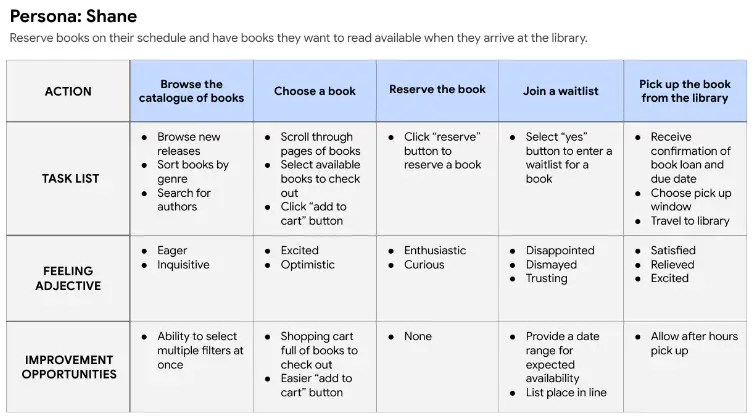
- Task List
- Action
- Improvement Opportunities
- Feeling Adjective
20. What elements make up a problem statement? Select all that apply.
- Solution
- Characteristics
- Name
- Insights
- Needs
21. A design team is working on an app for a government information tool and suggests this problem statement: Casey just moved to the area and needs to get information about setting up utilities because he doesn’t know who to contact. What element is missing in the problem statement?
- Insight
- User need
- User name
- User characteristics
22. Consider the following persona and answer the following question:
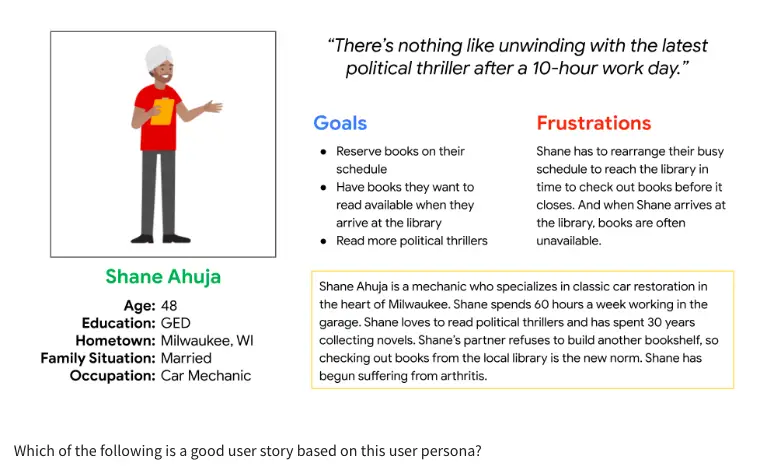
- As a professional and avid reader of political thrillers, I want to build another bookshelf, so I can collect more books.
- As a social person and busy professional, I want to adjust my work hours, so that I can check out books before the library closes.
- As a busy professional and avid book lover, I want to be able to reserve books in advance, so that I can pick them up based on my schedule.
23. What is the final step in conducting a competitive audit?
- Outline the goals
- Summarize your findings
- Research each product
- Create a list of your competitors
24. You decide to design a global communication app for a mobile device first. Which of the following factors contribute to your decision?
- Users will have reliable internet access
- Users will be in a metropolitan area
- Users will be located in emerging markets
- Users will be at home or work when they access the product
25. Fill in the blank: Designing solutions for the next billion users (NBU) should include solutions based on a _____ philosophy, so they can be accessible for all of these new potential users.
- desktop-first
- mobile-first
- data-first
- privacy-first
26. Why should designers take a mobile-first approach when designing solutions for new potential users?
- Adopting a mobile-first approach converts mobile users to desktops users.
- Using a mobile-first approach is best for global users, since most people use a mobile phone to access the internet.
- Focusing on mobile users first offers a quicker path to a product’s launch.
- Prioritizing mobile users ensures access for those with access to other devices.
27. You design a banking app for mobile and desktop devices that can alert users about large deposits or withdrawals. The mobile notifications provide limited information in one sentence, while the desktop notifications provide complete details. Which of the four C’s do these features represent?
- Continuity
- Complementary
- Consistency
- Context
28. A design team is working on a design project for a bill pay app. They have to design the app quickly and with a limited budget. Which of the following app types would work best in this scenario?
- Dedicated mobile app
- Android app
- Responsive web app
- iOS app
29. Review the journey map for user persona Shane: Shane is ready to pick up books from the library, but is unsure of the process to complete this action. Based on this pain point, you provide detailed instructions for Shane to test their ability to pick up the books. Which row in the journey map should include those instructions?
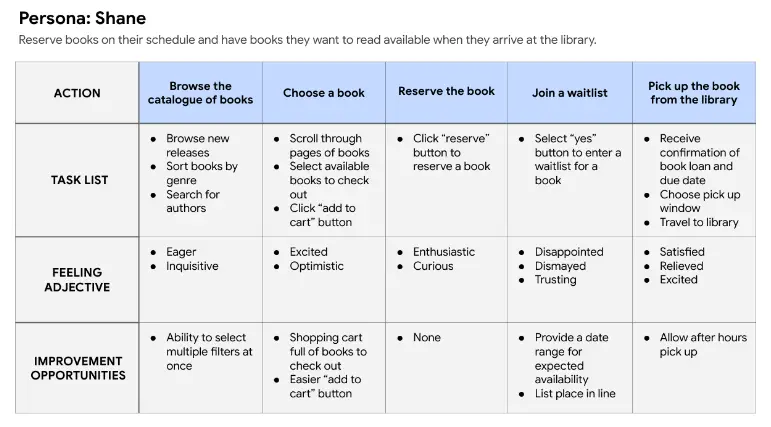
- Improvement Opportunities
- Task List
- Action
- Feeling Adjective
30. Consider the following persona and user story:
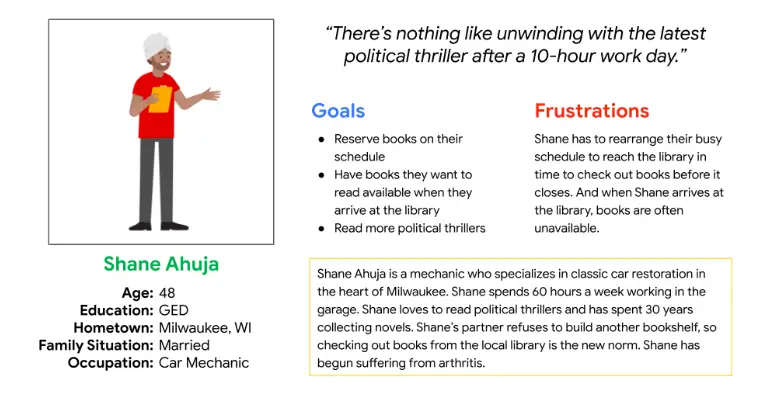
"As a busy professional and avid book lover, I want to be able to reserve books in advance, so that I can pick them up based on my schedule.”
What component of the user story addresses the persona’s goal to access books they want to read when they arrive at the library?
- Demographic
- Role
- Action
- Benefit
31. Fill in the blank: When outlining your goals in a competitive audit, you should include your users, _____, and the product’s industry.
- a list of the competitors
- specific information about your product
- how your product can beat the competition
- the competition’s goals
32. What question should you ask when deciding which device to design for first?
- Where will users go once they access the app or website?
- How much do users pay for internet access, cellular access, or wi-fi signal?
- Where will users be when they access the product?
- When will users access the product?
33. What is limited in the Crazy Eights exercise?
- Time
- Creativity
- Space
- Shape
34. A designer wants to design for the smallest and most basic version of their site, like for a mobile phone. What approach should they use?
- Dedicated desktop web design
- Graceful degradation
- Progressive enhancement
- Dedicated mobile app design
35. A designer wants to build a store locator app that requires access to a user’s location while in use. Which app type would be the best option for this build?
- Responsive web app
- iOS app
- Dedicated mobile app
- Android app
36. Problem statements help designers propose a specific, measurable solution that addresses the user’s goals and pain points. Which of the following is a quality of a great problem statement?
- Human-centered
- Open-ended
- Detail-oriented
- Single-minded
37. When conducting a competitive audit, what is the next step after creating a list of your competitors?
- Identify specific features for comparison
- Outline the goals
- Analyze findings
- Summarize findings
38. What is the objective of the Crazy Eights exercise?
- To validate your product design
- To come up with rough sketches of your future product
- To establish a clear user flow
- To make final decisions about future visual designs
39. Fill in the blank: Problem statements are a succinct way to reference a user’s needs. They also help designers _____.
- create a user group
- develop a design system
- establish the intent of a design
- build wireframes and prototypes
40. A problem statement helps designers create the vision for the design. Which of the following is an example of a strong problem statement?
- A teenager needs a scheduler app because they participate in a lot of extra-curricular activities.
- Lynn wants a smart device-enabled recipe app to help with cooking meals.
- Joshua is a new business owner who needs a tool for tracking expenses easily while on-the-go because he travels a lot for business.
- Rachel needs an app for a music library.
41. Fill in the blank: One of the four Cs, _____ ensures a uniform design so users can expect it to feel familiar across devices and products.
- Consistency
- Complementary
- Context
- Continuity
42. Review the journey map for user persona Shane: Shane was able to reserve books, but was frustrated with the limited quantity of books they were allowed to reserve. Which row in the journey map would include Shane’s pain points?
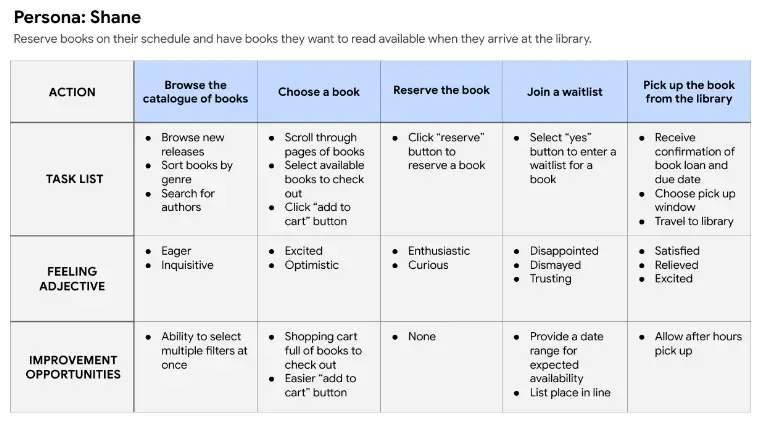
- Task List
- Improvement Opportunities
- Action
- Feeling Adjective
43. If the majority of users accessing a site are likely to use a mobile device, what are some best practices for building a site with these users in mind? Select all that apply.
- Keep the mobile site consistent with the same content as the desktop site.
- Limit the access to only what’s available on both mobile and desktop devices.
- Provide features that take advantage of the unique benefits of mobile phones.
- Organize the site so it’s easy for users to find what they want.
44. A design team is working on a design project for an event ticketing app to reduce paper tickets. They suggest the following design problem statement: Ricki is an avid sports fan and wants to avoid printing tickets that will be discarded once they’re in the stadium. What element is missing in the problem statement?
- User name
- Insight
- User need
- User characteristics
